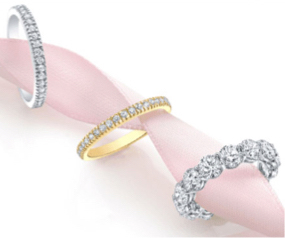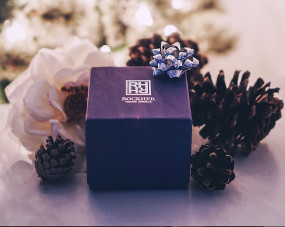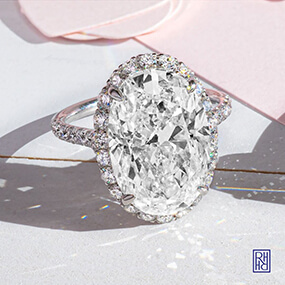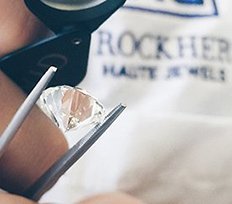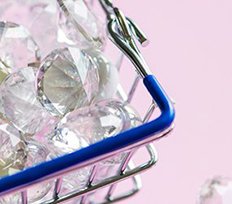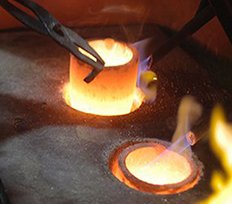If you ask your jeweler (or the entire internet) what color grade you should choose for your diamond, you’ll probably hear that you should choose a G-color diamond. Why is G the most popular color grade for diamond engagement rings? G-color is the top diamond color grade in the near-colorless color range. These are diamonds that professionals can tell have a slight tint of color but that appear colorless to the rest of us.
The D-to-Z diamond color scale, created in the 1950s by the Gemological Institute of America, starts at D for completely colorless diamonds, and continues through the alphabet to Z for diamonds that are light yellow or brown. (Fancy colored diamonds, which have more noticeable color than Z diamonds, have their own separate grading scale that describes hue as well as color intensity.)
Most diamonds have a faint yellow tint thanks to nitrogen atoms in their atomic structure that absorb blue, leaving a slightly yellowish body color. These are known as the “Cape series” diamonds after the first big diamond mining area in South Africa. The colorless grades, D, E, and F color diamonds, show the least visible color. G, H, I and J color diamonds, the “near colorless” grades, have color that is more visible to the trained eye.
But the hint of yellow in a G-color diamond is very difficult to see during everyday wear (or even hour after hour of constantly admiring your engagement ring. No judgement!) G-color diamonds face-up colorless even in a platinum, palladium, or white gold engagement ring setting. G-color diamonds are also the most popular choice for small accent diamonds in fine quality jewelry.
To detect the hint of color in a G-color diamond, the gem is graded in a gemological laboratory upside down so that the body color of the gem is visible without being diluted by its brilliance, scintillation, and dispersion (the three characteristics that give a diamond its sparkle and shine.)
The color in white diamonds occurs as continuous gradient shading from colorless to light yellow or brown. Diamond color grades chop this smooth curve of increasing color into discrete steps. There aren’t just D, E, F and G colors, there is a spectrum of diamonds with gradually more color until suddenly a boundary is crossed and the next grade begins. The difference at each step is almost imperceptible.
Drawing the lines between diamond color grades is very difficult. To make it a bit easier, every diamond’s color is evaluated in comparison to other diamonds with known grades called a diamond master set. That’s the only way to see the slight differences in color or absence of color that characterizes the color ranges that make up each of the GIA color grades.
To make grading diamond color consistent, gemological laboratories like GIA standardize the grading environment with a standard light source and white background when comparing the color of a diamond to the set of diamond master stones. At GIA, at least two graders give their opinion on each diamond’s color grade. If they disagree, more graders will grade the gem until enough graders agree on the proper grade (the number required depends on the size of the diamond.)
What does G color really mean? It means that this diamond, when placed upside down next to a diamond master set, can be seen by a trained professional to have slightly more color than F color but slightly less than an H color diamond. The slight differences in color can only be seen consistently in comparison, face down, in a controlled environment.
Will you be able to tell that your diamond is a G-color when you wear it in an engagement ring? If your diamond is set in platinum or another white metal like palladium or a bright white gold, professionals will be able to see that your diamond is colorless or near colorless but not its exact color grade.
The difference that a G color makes to your diamond’s beauty is less noticeable than the difference that cut quality makes. But if you want an almost colorless diamond at an accessible price point, G-color is a good choice for your diamond.
WHAT ROSI RECOMMENDS
You will be in good company if you choose a G-color diamond for your engagement ring. This near-colorless grade is the most popular recommendation for engagement rings. ROSI picks G color diamonds for step cut diamonds like emerald cuts and Asscher shapes which tend to show more color in the face up position because of larger facets. The large facets of bigger diamond sizes also make color a bit easier to see. (For round brilliants and other shapes with smaller facets ROSI will more often choose H-color diamonds, which usually represent a better value since a lot of buyers are competing for the commonly recommended G-color qualities in common engagement ring sizes.) ROSI will automatically take diamond shape and size into account when evaluating diamond color and finding you the best value diamond for your budget.
How does ROSI know diamonds so well? We trained her with dozens of professional diamond buyers. We asked them which diamonds among thousands they would buy for themselves or their daughters. ROSI calculated how they balanced more than 30 individual quality factors and applies those lessons to sift through all the grading reports of all the diamonds available on the market to pick the best combination of quality and value. With ROSI, you’ll find that brilliant needle in the haystack every time.


